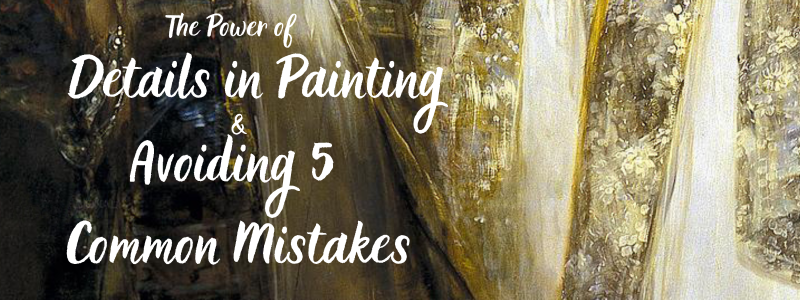Details are an integral part of a painting, helping to bring it to life and tell a story. Whether it’s the intricate patterns on a garment, the weathered lines on a face, or the delicate veins of a leaf, details can make a painting truly remarkable. In this lesson, we’ll explore why details are important, and how you can use them to bring your paintings to life. We’ll also cover the most common mistakes I see students make with details in their paintings.
The Importance of Details in Painting
Details can make a painting unique and memorable. They add depth and dimension to a painting, helping to bring it to life and create a sense of realism. By using details, you can create a story in your painting, whether it’s through the expression on a face, the textures of a landscape, or the intricate patterns of a still life.
Details also help to create a sense of movement and energy in a painting. For example, the fluttering of a flag, the swaying of a tree, or the movement of water can all be conveyed through the use of details. By adding details, you can bring a sense of life and energy to your paintings, making them truly captivating. Details also supply our brains with enough information to make a scene feel believable.
How to Use Details in Your Paintings
There are many ways to use details in your paintings, and the method you choose will depend on the type of painting you’re creating and the desired effect you want to achieve. Here are some popular methods for using details in your paintings:
- Close Observation: One of the most important aspects of adding details to your paintings is close observation. By studying the subject of your painting and paying attention to the details, you can create a more accurate and realistic representation. The closer we are to our subject matter, the more details we would be able to see in real life.
- Leading the Eye: Think about how you want to arrange the details in your painting and what story you want to tell through the composition.
Ways to Paint Details
- Smaller brush where the details are, broader brushwork elsewhere
- More brushstrokes
- Experimentation: Experimentation is key when it comes to adding details to your paintings. Try different brush strokes, textures, and techniques to see what works best for the subject of your painting.
- Variation of textures, colors, or values
- Layering: Layering is an excellent way to add details to your paintings. By building up multiple layers of paint, you can create a sense of depth and dimension, adding a sense of realism to your paintings.
Common Mistakes Made when Adding Details
- Too many
- Are they overwhelming to look at? Are the details creating chaos instead of a painting that draws you in. (Chaos can make us disengage from a painting.)
- Inconsistent
- Do you have details in one object in a painting, but none in another? This could be okay, if it is making sense. However, sometimes it is because we got carried away painting a certain area, and now we have an unevenness that we need to address. (Totally guilty of this so many times!)
- Not following realism rules (in a realistic painting)
- With landscapes, or anything with a realistic depth of field, we need to have more clarity in the foreground, and less in the background. (link below to downloadable help with this one!)
- Distracting instead of enhancing
- Does the area we detailed make sense to be detailed? The viewer will focus there. If it is a portrait, the eyes should be an area with the most details. You will notice face and hands tend to be the most highly rendered, and then the details may enhance those areas.
- Fussy
- Oh, fussiness. Our old nemesis. Sometimes details can become fussy quickly. I have an entire lesson just on how to break ourselves out of this. (See below for the link).
Fun Art History Lesson
One of my favorite paintings to discuss with students is Francisco Goya’s Charles IV of Spain and His Family. This painting gives us the opportunity to see the power of details in action. Due to imbreeding, the royal family at this point was not renowned for their beauty, to say the least. Here, Goya is able to create a family portrait that they loved by highlighting the details of their clothes and jewelry, and going a bit softer on the faces.

Pay attention to what is highly rendered with details, and what is allowed to be loose to not detract from the detailed areas.

The clothes are stunningly beautiful, the skin tones are allowed to be soft, and the features of the family are softened a bit to help them look better. There is a debate about this painting in art history. Was Goya ridiculing them, or was he doing his best at a job to make an ugly family presentable, despite his political views?
In the group of The Family of Charles IV, Goya, despite his position as court painter, has portrayed the ugliness and vulgarity of the principal figures so vividly as to produce the effect of caricature. – Encyclopaedia Britannica article
You didn’t manage to keep your job as an official court portraitist if you were satirising the people you were painting. No, this is not a send up. If anything it is an act of flattery. For instance on the left, in the blue suit, is one of the most odious little toads in the entire history of Spanish politics, the future King Ferdinand VII, whom Goya actually manages to make quite regal. God knows how he did it, but he has. This is very much an act of respect, almost verging on an act of flattery. – Robert Hughes, famous art critic
Either way, the detailing in this painting does the heavy lifting!
Details are an important aspect of painting, helping to bring your paintings to life and create a story. By using close observation, experimentation, layering, and composition, you can create truly remarkable paintings that are rich in detail and realism. So, next time you’re working on a painting, consider the power of details and see how they can bring your work to the next level.

